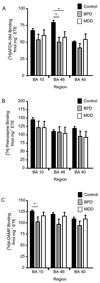Decreased muscarinic receptor binding in the frontal cortex of bipolar disorder and major depressive disorder subjects
- PMID: 19103464
- PMCID: PMC2724602
- DOI: 10.1016/j.jad.2008.11.015
Decreased muscarinic receptor binding in the frontal cortex of bipolar disorder and major depressive disorder subjects
Abstract
Background: Dysfunction of the cholinergic muscarinic receptors has been implicated in the pathology of bipolar disorder and major depressive disorder. However, there is conflicting evidence regarding the association between individual muscarinic receptors and the two disorders.
Methods: We used the muscarinic receptor selective radioligands [3H]pirenzepine, [3H]AFDX-384 and [3H]4-DAMP to measure the levels of muscarinic(1) (CHRM1) and muscarinic(4) (CHRM4) receptors, muscarinic(2) (CHRM2) and muscarinic(4) (CHRM4) receptors and muscarinic(3) (CHRM3) receptor, respectively. Radioligand binding was measured in Brodmann's area (BA) 10 of the rostral prefrontal cortex, BA 46 of the dorsolateral prefrontal cortex and BA 40 of the parietal cortex in the post-mortem CNS from subjects with bipolar disorder or major depressive disorder and control subjects.
Results: [3H]AFDX-384 binding was decreased in BA 46 in both bipolar disorder (p<0.01) and major depressive disorder (p<0.05). [3H]4-DAMP binding was decreased in BA 10 in bipolar disorder (p<0.05) but not major depressive disorder (p>0.05). [3H]AFDX-384 and [3H]4-DAMP binding were unaltered in any other cortical region examined for either disorder (p>0.05). [3H]pirenzepine binding was not significantly altered in either disorder in any cortical region examined (p>0.05).
Limitations: 9 bipolar disorder, 9 major depressive disorder and 19 control subjects were used in the study.
Conclusion: Our data is consistent with previously published data implicating a role for CHRM2 receptors in the pathology of bipolar and major depressive disorder. The demonstration of a novel association between decreased CHRM3 receptor expression and bipolar disorder suggests bipolar and major depressive disorder differs in the underlying nature of their cholinergic dysfunction.
Figures


References
-
- American Psychiatric Association. Diagnostic and Statistical Manual of Mental Disorders. 4th ed. Washington, DC: American Psychiatric Association; 1994.
-
- Araujo DM, Lapchak PA, Quirion R. Heterogenous binding of [3H]4-DAMP to muscarinic cholinergic sites in the rat brain: Evidence from membrane binding and autoradiographic studies. Synapse. 1991;9:165–176. - PubMed
-
- Blumberg HP, Stern E, Ricketts S, et al. Rostral and orbital prefrontal cortex dysfunction in the manic state of bipolar disorder. Am. J. Psychiatry. 1999;156:1986–1988. - PubMed
-
- Burdick KE, Endick CJ, Goldberg JF. Assessing cognitive deficits in bipolar disorder: Are self-reports valid? Psychiatry Res. 2005;136:43–50. - PubMed

